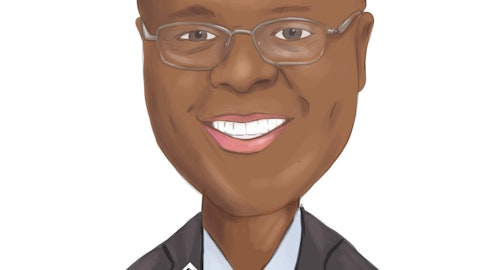First Western Financial, Inc. (NASDAQ:MYFW) Q3 2023 Earnings Call Transcript October 20, 2023
Operator: Good day and thank you for standing by. Welcome to the First Western Financial Third Quarter 2023 Earnings Conference Call. At this time, all participants are in a listen-only mode. After the speakers’ presentation, there will be a question-and-answer session. [Operator Instructions] Please be advised that today’s conference is being recorded. I would now like to hand the conference over to your speaker today, Tony Rossi, at Financial Profile. Please go ahead.
Tony Rossi: Thank you, Abigail. Good morning, everyone and thank you for joining us today for First Western Financial’s third quarter 2023 earnings call. Joining us from First Western’s management team are; Scott Wylie, Chairman and Chief Executive Officer; Julie Courkamp, Chief Operating Officer; and David Weber, Chief Financial Officer. We will use a slide presentation as part of our discussion this morning. If you’ve not done so already, please visit the Events & Presentations’ page of First Western’s Investor Relations website to download a copy of the presentation. Before we begin, I’d like to remind you that this conference call contains forward-looking statements with respect to the future performance and financial condition of First Western Financial that involve risks and uncertainties.

A finance executive overseeing the implementation of a tax solution. Editorial photo for a financial news article. 8k. –ar 16:9
Various factors could cause actual results to be materially different from any future results expressed or implied by such forward-looking statements. These factors are discussed in the company’s SEC filings which are available on the company’s website. I would also direct you to read the disclaimers in our earnings release and investor presentation. The company disclaims any obligation to update any forward-looking statements made during the call. Additionally, management may refer to non-GAAP measures, which are intended to supplement, but not a substitute for the most directly comparable GAAP measures. The press release available on the website contains the financial and other quantitative information to be discussed today, as well as the reconciliation of the GAAP to non-GAAP measures.
With that, I’d like to turn the call over to Scott. Scott?
Scott Wylie: Thanks, Tony. Good morning, everybody. The operating environment remained challenging in the third quarter, but we were able to deliver another quarter’s strong financial performance by executing well in those areas we can control, which helped us to offset the impact of things we can’t control, such as the higher interest rates that have reduced loan demand and created a very competitive deposit pricing environment. We generated net income of $3.1 million or $0.32 per diluted share in the third quarter with $4.6 million in pre-tax, pre-provision income, which was an increase of 17% from the prior quarter. As we’ve indicated previously, we’ve increased our focus on core deposit gathering around the organization, and we saw good results from these efforts during the third quarter, with total deposits increasing at an annualized rate of 7.5%.
While overall loan demand remains muted due to the higher interest rates, we’re still seeing attractive lending opportunities in our markets, which enable us to generate annualized loan growth of 5.6%, while maintaining our conservative underwriting standards and pricing criteria. The higher rates on our new loan production are well above the incremental cost of funding we’re seeing, which is making our new loan production accretive to our margin and relieving some of the margin pressure we’ve seen in prior quarters. With our success in deposit gathering, we were able to lower our loan to deposit ratio from the end of the prior quarter, which was one of our near-term priorities. As I mentioned earlier, we’ve been successful in areas we can control.
This includes our disciplined expense management, which resulted in our operating expenses coming in at the lower end of our targeted range in the third quarter. And we continue to have success in our Trust and Investment Management new business development efforts, which continue to offset the impact of lower market values on our assets under management during the third quarter. Broadly speaking, our loan portfolio continues to perform well, although we did have an increase in NPAs this quarter, primarily due to the downgrade of four loans, totaling $42 million that are all related to one relationship. These loans consist of a commercial loan, an owner-occupied commercial real estate loan, a residential mortgage, and a personal line of credit.
This is a client we’ve had since 2018 and had good experience with. However, they’re currently facing a liquidity crunch and become delinquent on their payments, which resulted in the placement of these loans on non-accrual. Given our conservative underwriting criteria and the multiple sources of repayment we require, these loans are well-collateralized with a number of properties. The borrower is planning a number of liquidity events, including the sale lease properties that should result in a full repayment of the loans. It will likely take a few quarters for these loans to be resolved, but given the strong borrower and collateral that we have, we believe the loss potential is minimal. Moving to Slide 4, we generated net income of $3.1 million or $0.32 per diluted share in the third quarter.
And over the past year, due to our strong financial performance and prudent balance sheet management, we’ve seen increases in both book value and tangible book value per share despite the impact of capital resulting from our adoption of CECL at the beginning of the year. Now I’ll turn the call over to Julie for some additional discussion of our balance sheet and Trust and Investment Management trends. Julie?
Julie Courkamp: Thank you, Scott. Turning to Slide 5, we’ll look at the trends in our loan portfolio. Our total loans increased $35 million from the end of the prior quarter. The increase was driven by growth in our commercial, residential mortgage and construction portfolios, which was offset by a decline in the CRE loans due to an increase in payoffs that we saw during the quarter. As this has been the case over the past few quarters, the increase we are seeing in construction loans are related to draws on credit lines, primarily related to residential housing projects, being built by very strong experienced developers in areas with limited housing supply. As we mentioned on our last earnings call, we saw an increase in loan production during June and this continued through the third quarter.
We had more than $100 million in new loan production, which is our highest quarter so far this year. And with the discipline we are maintaining and our pricing criteria, the average rate on new production increased 51 basis points from the prior quarter to 7.92% and was 8.44% in the month of September. Moving to Slide 6, we’ll take a closer look at our deposit trends. Our total deposits increased by $45 million during the quarter. We continued to have success in new business development and added $26 million in new deposit relationships during the third quarter. The mix of deposits continue to reflect a trend of clients moving money out of non-interest-bearing accounts into interest-bearing accounts in order to get higher yields on their excess liquidity.
Turning to Trust and Investment Management on Slide 7, we had $108 million decrease in our assets under management in the third quarter, primarily due to market performance, which is partially offset by inputs from new clients that we added during the quarter. Now I’ll turn the call over to David for further discussion of our financial results. David?
David Weber: Thanks, Julie. Turning to Slide 8, we’ll look at our gross revenue. Our gross revenue declined 6.6% from the prior quarter as a decline in net interest income was partially offset by an increase in non-interest income. The non-interest income mix increased to 26.7% from 17.7% in the prior quarter. Turning to Slide 9, we’ll look at the trends in net interest income and margin. Our net interest income decreased 9.1% from the prior quarter due to an increase in interest expense resulting from a higher average cost of deposits. Our net interest margin decreased 27 basis points to 2.46% driven by an increase in interest-bearing deposit costs and slightly lower yields on average earning assets. We did not accrue interest on the loans placed on non-performing status in the quarter, which included the $42 million of loans under one relationship that Scott discussed.
These loans accounted for 20 of the 27 basis point decline that we had in our net interest margin in the quarter. Given the current trends we are seeing, we expect pressure on our net interest margin to moderate in the fourth quarter. Turning to Slide 10, our non-interest income increased 54% from the prior quarter primarily due to items that impacted our second quarter non-interest income. Third quarter included $300,000 of losses accounted for under fair value impacting EPS by $0.02. Among our larger recurring sources of non-interest income, our Trust and Investment Management fees increased 5.3% due to an increase in our fee structure to bring us more in line with market rates and to reflect the additional value we are providing through enhancements we have recently made to our service level and technology platform.
Net gain on mortgage loans decreased to approximately $700,000 as higher rates continue to impact loan demand. Approximately 91% of the mortgage originations were for purchase loans in the third quarter. And we had a slight decline in bank fees due to lower loan prepayment and swap fees relative to the prior quarter. Turning to Slide 11 and our expenses. Our non-interest expense decreased 1.1% from the prior quarter with slight declines in most of our major line items as we continue to focus on disciplined expense control. Our salaries and benefits expense in the third quarter included approximately $400,000 of acquisition-related compensation expense that was accelerated due to an early termination. This impacted EPS by $0.03. For the fourth quarter, we continue to expect our non-interest expense to range between $18.5 million and $19 million.
Now turning to Slide 12, we’ll look at our asset quality. On a broad basis, the loan portfolio continues to perform very well as we had another quarter of minimal losses. The increase in non-performing assets was primarily driven by the downgrade of the $42 million in loans related to a single relationship. These loans are now being individually analyzed and given the strong collateral that we have, we did not require a specific reserve for these loans and the downgrades did not impact our provision expense. We recorded a provision for credit losses of approximately $300,000 in the quarter. The provision recorded this quarter combined with the modest level of loan growth, increased our level of allowance to adjusted total loans by 3 basis points to 92 basis points on September 30th.
Now, I will turn it back to Scott. Scott?
Scott Wylie: Thanks, David, and congratulations on getting through your first earnings call there. So great to have you on the call with us. Thank you. Turning to Slide 13, we provided an update on our strong track record of value creation for shareholders. This slide shows our trend in tangible book value per share since our IPO in 2018, and the factors that have contributed to our consistent ability to drive the growth in tangible book value per share as we’ve executed well on the plan that we communicated at the time of our IPO. Following our third quarter performance, we’ve now increased our tangible book value per share by 144% since our IPO, which includes the $0.56 decrease that we had due to the adoption of CECL at the beginning of 2023.
We’re very proud of this track record of value creation and believe that we’re well positioned to continue creating additional value for our shareholders in the future. Turning to Slide 14, I’ll wrap up with some comments about our near-term outlook. While there’s a high degree of economic uncertainty, we’re going to continue to perform to prioritize prudent risk management and maintain high levels of liquidity, capital and reserves, even if that impacts our level of profitability in the short-term. Most importantly, we’ll continue to focus on controlling the things that we can control, including our balance sheet management, attracting new clients, particularly those that provide core deposit relationships and trust and investment management assets, providing exceptional service to existing clients and tightly managing our expenses.
By continuing to execute well in these areas, we believe we can continue to offset the impact of a challenging macroeconomic environment and deliver strong financial results for our shareholders in the near-term. At the same time, we continue to operate with a long-term approach and make investments that we believe will further enhance our business development capabilities. This includes recently opening our first full-service office in the Bozeman, Montana market, where we previously only had a loan production office. Since entering this market, we’ve steadily built out the team and clients with now a full-service office, we believe we can accelerate our business development activities in this area. With the strategic investments that we continue to make, we believe we’re well positioned to continue capitalizing on the attractive markets that we operate in to consistently add new clients, realize more operating leverage as we increase our scale, generate profitable growth and further enhance the value of our franchise over the long-term.
With that, we’re happy to take your questions. Abigail, please open up the call.
See also Top 20 Most Fit Cities in the US and 20 States That Have The Cheapest Electricity In The US.
Q&A Session
Follow First Western Financial Inc (NASDAQ:MYFW)
Follow First Western Financial Inc (NASDAQ:MYFW)
Operator: Thank you. At this time, we’ll conduct the question-and-answer session. [Operator Instructions] Our first question comes from Brady Gailey with KBW. Your line is open.
Brady Gailey: Hey, thank you. Good morning, guys.
Scott Wylie: Good morning, Brady.
Brady Gailey: I just wanted to start with the net interest margin. As I look over the last three quarters, every quarter it’s been a pretty big step down. It sounds like that’s going to moderate in 4Q, But I’m just wondering where you think the margin finds the bottom? And is that in 4Q? And as we look to next year, do you think the margin is stable? Do we think it could have some upside from asset re-pricing? Like how are we thinking about the margin into 2024?
Scott Wylie: Yeah, great question, Brady. So, obviously it’s been a difficult year to forecast NIM given the number of variables and the unusual operating environment we’ve been. And one of the things I looked at is kind of the month-by-month trend line. And we did see in the last quarter on this call that we thought that once the Fed stopped raising short-term rates that our deposit cost would stabilize and our asset yields would improve, which would drive a higher NIM. Unfortunately, in July, we had another interest rate increase, which given the number of deposits we have with kind of 100% bait on them, we saw a significant increase in our deposit costs in Q3. So that was not particularly helpful to short-term results. But, if you look at this quarter, month-by-month, we were kind of in the 250s each month.
And so I’m hopeful that if we don’t see another short-term interest raise by the Fed, which is, I think what the market is expecting at this point that there won’t be one, that we can see stabilizing deposit costs for us. Again, I’ve talked before about the fact that I think our clients are kind of ahead of the typical bank clients because of the fact that they’re larger and more sophisticated. And so, going into Q4, hopefully we see stabilized deposit costs and improving asset yields. So at least we’re stable to maybe a little bit of margin compression in Q4, our numbers going into 2014, we’re assuming higher for longer, but flat on the short end to where we are today. So, if that’s the scenario, then I think you see the benefit of the higher asset yields playing out over the course of the year.
And I think the interesting thing, this kind of goes back to our IPO too. I think the interesting thing for our business model is, if that plays out like that and we can see stable funding costs, higher asset yields and well-controlled operating expenses, then you see improved earnings which is, what I talked about in my comments.
Brady Gailey: Yep. And then a similar question on the expense side, whether you guys are expecting $18.5 million to $19 million of expenses to finish the year. Can you hold those expenses flat next year? Or do you think you see some modest creep? How do you think about expense growth in ‘24?
Scott Wylie: Our assumption is to accomplish the things we want to do long-term for shareholder, we need to continue to invest. And we have that built into our $18.5 million to $19 million. So, all other things being equal, we believe we can hold expenses in the ballpark of where they are now. Of course, there’s a little bit of seasonality with, what is the FICA —
David Weber: Payroll taxes —
Scott Wylie: Yeah, payroll taxes as you get in the first quarter, stuff like that. But generally, our starting point for our planning for next year is, let’s figure out how to hold expenses flat and show some revenue improvement which would drive some operating leverage and improved earnings.
Brady Gailey: All right. And then finally for me, the $42 million relationship that went into non-performing, I think you said it was four loans. So did all four of those loans stop paying interest or was it just one?
Scott Wylie: Yeah. This was an interesting case. , we thought that we were going to get this guy permanent in Q3. And he’s a wealthy guy that has cash crisis going on right now. But at the end, we decided that what we would have had to give up to get him permanent wasn’t worth it to us, and we would just soon take our lumps here and see the increase in NPAs, which seems to happen to us once every five years, where we get a wealthy person gets into trouble and we have to work them out. And so, this guy is, we think, still very strong. We think we’re going to have a full recovery. The real estate collateral that we have is in some very desirable markets. It’s in Aspen, it’s in Nantucket, and it’s in the West Palm Beach area. So, it was just an article in the Wall Street Journal, I think yesterday, talking about how hot the high-end market, the premium market is in Aspen, which is already a premium market, but they’re talking about how that continues to be a very desirable market.
And so, I think, , as we move to either he or we get liquidity on those properties, I think that that’s all going to turn out fine. And as we work through — work out, it’s going to take a while like I said in my comments.
Brady Gailey: Okay. All right, great. Thanks for all the color, Scott.
Scott Wylie: Yep, thank you, Brady.
Operator: One moment for our next question. Our next question comes from Brett Rabatin with Hovde Group. Your line is open.
Brett Rabatin: Hey, good morning, Scott and Julie.
Scott Wylie: Good morning, Brett.
Brett Rabatin: I wanted to ask, back on the margin, just, obviously that non-accrual relationship was, I think, 20 of the 27 basis points of pressure. When you were giving comments around the margin, how does that relationship play into what you were talking about on the margin? I assume it kind of excludes it. What, and it sounds like it’s a few quarters before maybe that gets resolved?
Scott Wylie: Well, that will definitely come back to our benefit at some point. , it’s non-accrual now, so it’s going to stay non-accrual as we collect on it. I assume we’re going to collect past interest, penalty interest, and that will be a nice benefit in the future at some point, but I don’t think that’s going to be next week. It’s going to be a little while. So I think for the short-term quarterly reporting, it’s going to be a zero. But depending how it all plays out, I think we will get that back at some point.
Brett Rabatin: Okay. And then you had some solid long growth this quarter. Just was hoping for some additional color around, , pipelines and, , as you think about the environment in ‘24, if you think there’s going to be a lot of opportunities to add, some new business or are you going to be a little more selective and maybe slow the balance sheet growth from here in terms of loan portfolio? How do you think about that?




